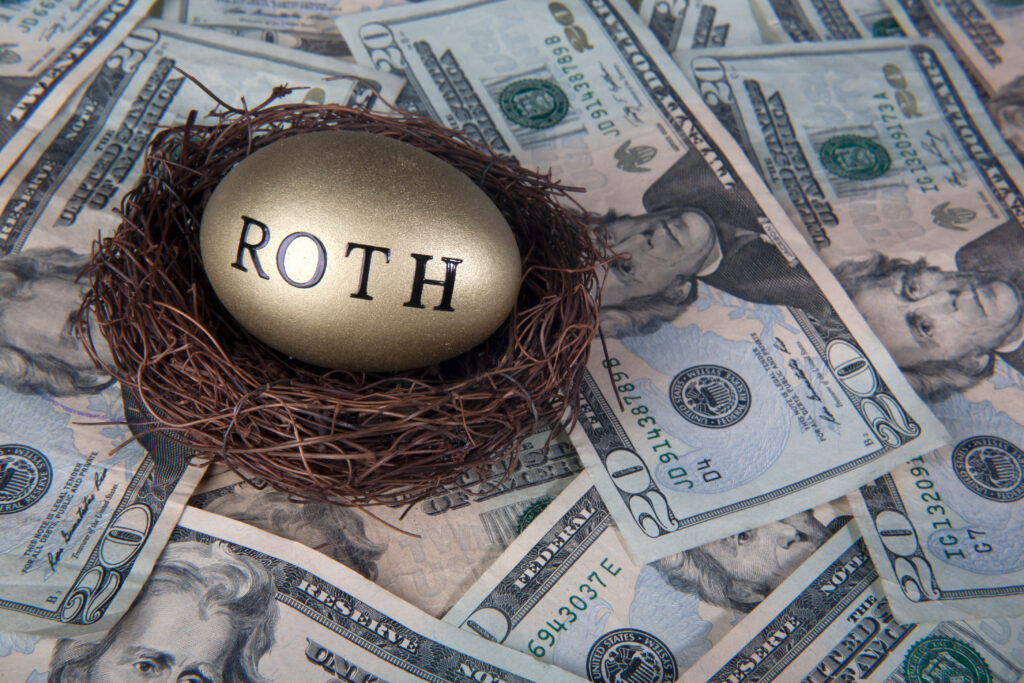The Roth Way to Riches

The Roth Way to Riches
By Roy Lewis
With all the recent tax-code changes, it seems a number of taxpayers have forgotten the Roth IRA. That’s a shame, because it’s far more than an ordinary retirement savings account.
Roth IRAs are tax-favored accounts to which qualified taxpayers can make non-deductible, after-tax contributions. Those contributions can grow tax-free, and neither they nor the earnings they generate are subject to tax if withdrawn as a qualified distribution.
Although a Roth IRA is designed to help taxpayers save for retirement, it can also offer tax, estate-planning, and financial-planning advantages unavailable to a traditional IRA:
First, there’s no age limit to contributions to a Roth IRA. A person who has reached age 70 1/2 by the end of the year cannot make contributions to a traditional IRA.
Second, qualified distributions from a Roth IRA are completely tax-free. To qualify, distributions must be made more than five years after the contribution, and taken after the owner has turned age 59 1/2, died, or become disabled. Distributions are also available for certain special purposes, including the purchase of a first home. With a traditional IRA, distributions are fully taxable, except to the extent they represent the return of after-tax contributions.
Third, unlike traditional IRA owners, a Roth IRA owner is not required to begin taking distributions from the account at age 70 1/2. The tax-free accumulation can continue throughout the owner’s life.
Fourth, distributions of Roth IRA contributions — money the owner personally put into the Roth IRA, as opposed to the additional earnings generated by those contributions — are always tax-free, no matter when they are taken.
A taxpayer deciding to take lifetime distributions can benefit from the favorable tax treatment accorded to Roth IRAs. Like traditional IRAs, Roth IRAs provide for tax-deferred earnings. However, since no tax is imposed on a qualified Roth IRA distribution, this benefit is increased. Because tax-free distributions of earnings can occur only after the five-year requirement is satisfied, the sooner you contribute to a Roth IRA, the more you can save on taxes (and earn in returns). Parents or grandparents may want to consider setting up and funding a Roth IRA for their children or grandchildren as soon as those children or grandchildren have enough earned income from part-time or summer jobs. This will ensure that the five-year requirement is met when the individual for whom the Roth IRA is established is ready to make a withdrawal — to buy a home, for example.
The lack of minimum required distributions makes Roth IRAs very useful as estate-planning tools, assuming the owner doesn’t need the funds in the account. The owner can leave the account intact for his or her heirs, thereby maximizing its tax-free growth. In other words, if the owner doesn’t take distributions from the account, his or her heirs will receive a larger amount. In addition, beneficiaries of a Roth IRA can take completely tax-free distributions from the account throughout their entire lives. And if the beneficiary doesn’t need the funds immediately, that money can keep growing tax-free for years to come. (The Roth IRA owner can maximize this strategy by naming a young beneficiary).
Taxpayers’ ability to withdraw the annual contributions they make to a Roth IRA tax-free at any time means that these accounts can serve financial-planning goals no traditional IRA could meet. Before making a contribution to a traditional IRA or other retirement plan, taxpayers must make sure that they can afford to do without the funds for some period of time, since taxes and heavy penalties are imposed on early withdrawals. But that’s not the case with a Roth IRA; withdrawals before the five-year requirement are tax-free, as long as they consist only of contributions. In addition, the tax on early withdrawals is imposed only to the extent that the withdrawal is included in income.
Suppose that you contribute your $4,000 annual lump sum to a Roth IRA. (That’s the maximum allowable amount for tax year 2006; taxpayers 50 or older can also contribute an additional $1,000 in “catch up” funds.) One week later, you withdraw $1,000 from the Roth IRA. That withdrawal is not subject to tax, which lets the Roth IRA act as a tax-deferred emergency fund — provided that you withdraw no more than you’ve previously contributed.
Another example: Suppose you’ve contributed $2,000 each year to a Roth IRA in 2003, 2004, and 2005. In October 2006, when the account’s total contributions and earning are worth $8,000, your roof sustains $5,000 in hail damage, and your insurance won’t cover it. Since you contributed a total of $6,000 to your Roth IRA over the years, you can withdraw $5,000 from it tax-free to pay for the damage. (When applying this rule, distributions from a Roth IRA are assumed to come from contributions first.)
Because you can take contribution distributions tax-free, it’s crucial that you keep accurate records of the amounts you contribute to a Roth IRA. If a withdrawal is made from the account, you’ll be able to show that it’s coming from contributions, and is therefore tax-free.
As you can see, Roth IRAs can be a very important component of your retirement plan and your overall financial plan. Your most Foolish strategy, of course, is to avoid taking early distributions from your Roth IRA whenever possible, to allow the greatest amount of money to grow and compound tax-free over the longest possible time. Nonetheless, you shouldn’t overlook the many other advantages that Roth IRAs have to offer.
©1995-2006 The Motley Fool. All rights reserved.
—————————————————————————————————————————————————————————————————————
We hope you found this article about “The Roth Way to Riches” helpful. If you have questions or need expert tax or family office advice that’s refreshingly objective (we never sell investments), please contact us or visit our Family office page or our website at www.GROCO.com. Unfortunately, we no longer give advice to other tax professionals gratis.
To receive our free newsletter, contact us here.
Subscribe our YouTube Channel for more updates.

Alan Olsen, is the Host of the American Dreams Show and the Managing Partner of GROCO.com. GROCO is a premier family office and tax advisory firm located in the San Francisco Bay area serving clients all over the world.
Alan L. Olsen, CPA, Wikipedia Bio

GROCO.com is a proud sponsor of The American Dreams Show.

The American Dreams show was the brainchild of Alan Olsen, CPA, MBA. It was originally created to fill a specific need; often inexperienced entrepreneurs lacked basic information about raising capital and how to successfully start a business.
Alan sincerely wanted to respond to the many requests from aspiring entrepreneurs asking for the information and introductions they needed. But he had to find a way to help in which his venture capital clients and friends would not mind.
The American Dreams show became the solution, first as a radio show and now with YouTube videos as well. Always respectful of interview guest’s time, he’s able to give access to individuals information and inspiration previously inaccessible to the first-time entrepreneurs who need it most.
They can listen to venture capitalists and successful business people explain first-hand, how they got to where they are, how to start a company, how to overcome challenges, how they see the future evolving, opportunities, work-life balance and so much more..
American Dreams discusses many topics from some of the world’s most successful individuals about their secrets to life’s success. Topics from guest have included:
Creating purpose in life / Building a foundation for their life / Solving problems / Finding fulfillment through philanthropy and service / Becoming self-reliant / Enhancing effective leadership / Balancing family and work…

MyPaths.com (Also sponsored by GROCO) provides free access to content and world-class entrepreneurs, influencers and thought leaders’ personal success stories. To help you find your path in life to true, sustainable success & happiness. It’s mission statement:
In an increasingly complex and difficult world, we hope to help you find your personal path in life and build a strong foundation by learning how others found success and happiness. True and sustainable success and happiness are different for each one of us but possible, often despite significant challenges.
Our mission at MyPaths.com is to provide resources and firsthand accounts of how others found their paths in life, so you can do the same.
How Will Billion Dollar Lottery Winner Fair Under New Tax Law?
How Will Billion Dollar Lottery Winner Fair Under New Tax Law? What would you do if you won $1.5 billion dollars? That’s exactly what happened for one ultra lucky individual in October. The life of the winner of the largest single ticket jackpot in history will never be the same. What about his or her…
What a $1000 Investment in Tesla 8 Years Ago Is Worth Now
Have you ever fancied yourself zooming around in a Tesla? Perhaps you already own one of these amazing vehicles. You might even own stock in the company. Many Tesla drivers have also invested in the company. So what is that investment worth? At the time of this writing, Tesla Shares were worth roughly $320 each. No doubt that…
Are All Fines Non-Deductible?
Are All Fines Non-Deductible? A few weeks ago Elon Muck made some big news when he got in trouble with the SEC. The agency investigated the Tesla CEO after he made public comments about possibly taking the company private. There was even talk he could be ousted from Tesla. In the end, he was able to keep his post…
Could You Claim a Tax Credit for Your Nanny?
Could You Claim a Tax Credit for Your Nanny? Although tax laws have certainly changed under the Tax Cut and Jobs Act, there are still numerous tax credits available. Some of these credits are obvious. But there are several you might be overlooking. For example, did you hire or use a nanny throughout the year? Many high net worth…




